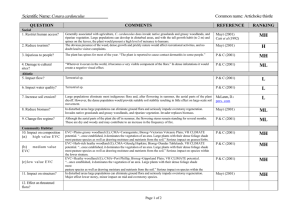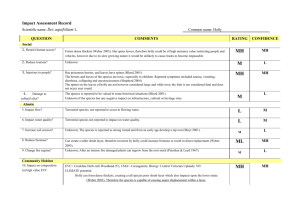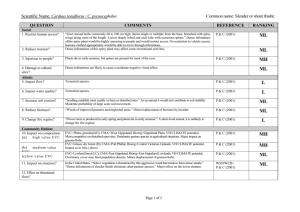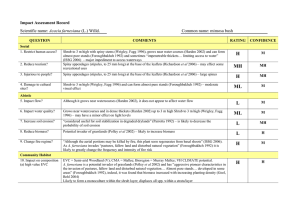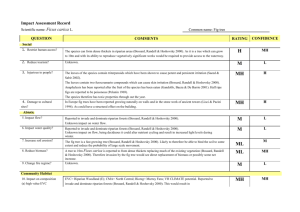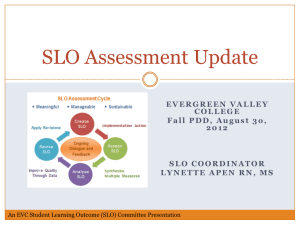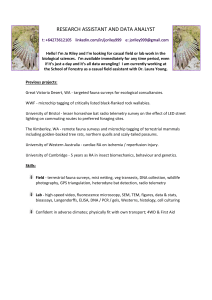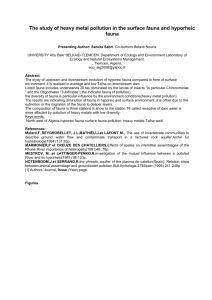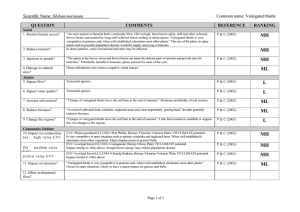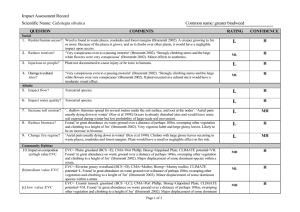Impact Assessment Record - Box Elder
advertisement
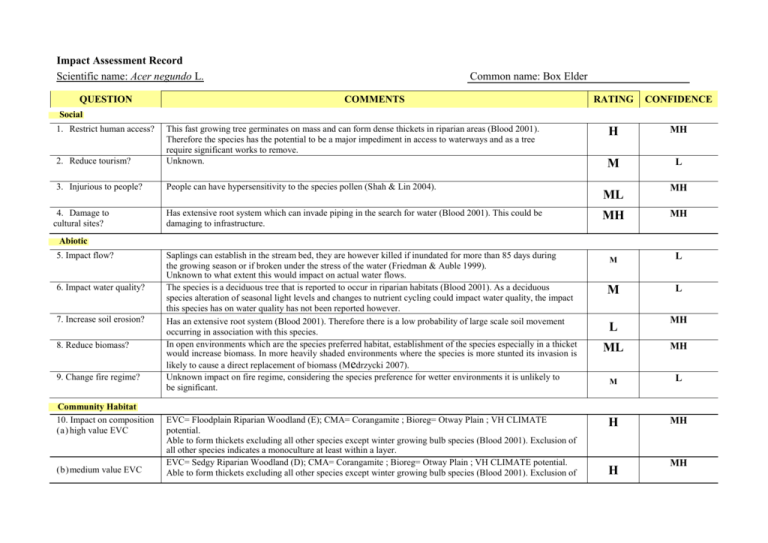
Impact Assessment Record Scientific name: Acer negundo L. QUESTION Common name: Box Elder COMMENTS RATING CONFIDENCE H MH M L Social 1. Restrict human access? 2. Reduce tourism? This fast growing tree germinates on mass and can form dense thickets in riparian areas (Blood 2001). Therefore the species has the potential to be a major impediment in access to waterways and as a tree require significant works to remove. Unknown. 3. Injurious to people? People can have hypersensitivity to the species pollen (Shah & Lin 2004). 4. Damage to cultural sites? Has extensive root system which can invade piping in the search for water (Blood 2001). This could be damaging to infrastructure. ML MH MH MH M L M L Abiotic 5. Impact flow? 6. Impact water quality? 7. Increase soil erosion? 8. Reduce biomass? 9. Change fire regime? Community Habitat 10. Impact on composition (a) high value EVC (b)medium value EVC Saplings can establish in the stream bed, they are however killed if inundated for more than 85 days during the growing season or if broken under the stress of the water (Friedman & Auble 1999). Unknown to what extent this would impact on actual water flows. The species is a deciduous tree that is reported to occur in riparian habitats (Blood 2001). As a deciduous species alteration of seasonal light levels and changes to nutrient cycling could impact water quality, the impact this species has on water quality has not been reported however. Has an extensive root system (Blood 2001). Therefore there is a low probability of large scale soil movement occurring in association with this species. In open environments which are the species preferred habitat, establishment of the species especially in a thicket would increase biomass. In more heavily shaded environments where the species is more stunted its invasion is likely to cause a direct replacement of biomass (Medrzycki 2007). Unknown impact on fire regime, considering the species preference for wetter environments it is unlikely to be significant. EVC= Floodplain Riparian Woodland (E); CMA= Corangamite ; Bioreg= Otway Plain ; VH CLIMATE potential. Able to form thickets excluding all other species except winter growing bulb species (Blood 2001). Exclusion of all other species indicates a monoculture at least within a layer. EVC= Sedgy Riparian Woodland (D); CMA= Corangamite ; Bioreg= Otway Plain ; VH CLIMATE potential. Able to form thickets excluding all other species except winter growing bulb species (Blood 2001). Exclusion of L MH ML MH M L H MH H MH Impact Assessment Record Scientific name: Acer negundo L. QUESTION Common name: Box Elder COMMENTS RATING CONFIDENCE H MH H MH MH L MH L M L MH M L M ML H all other species indicates a monoculture at least within a layer. (c) low value EVC 11.Impact on structure? 12. Effect on threatened flora? EVC= Riparian Scrub (LC); CMA= West Gippsland ; Bioreg= Wilsons Promontory; VH CLIMATE potential. Able to form thickets excluding all other species except winter growing bulb species (Blood 2001). Exclusion of all other species indicates a monoculture at least within a layer. Able to form thickets excluding all other species except winter growing bulb species (Blood 2001). Therefore the species is capable of major displacement. Unknown; there is no evidence of this reported. Fauna 13. Effect on threatened fauna? Unknown; there is no evidence of this reported. 14. Effect on nonthreatened fauna? Significant alteration of habitat in terms of flora composition could have a significant impact on food supply for fauna species. The degree to which this species would impact on Australian fauna has not been quantified however. Even in the species native range it is generally avoided by foraging insectivorous birds (Gabbe et al 2002). As a moderate sized tree it may provide some shelter for species. There is no evidence reported to support this. 15. Benefits fauna? 16. Injurious to fauna? Pest Animal 17. Food source to pests? Browsed by deer species (Rossell, Gorsira & Patch 2005). 18. Provides harbor? Dense thickets of the species have been described as places of informal intimate social life (M edrzycki 2007). This dense vegetation cover could provide shelter for pest species. M M Agriculture 19. Impact yield? Not reported as a significant weed of agriculture. L M 20. Impact quality? Not reported as a significant weed of agriculture. L M Impact Assessment Record Scientific name: Acer negundo L. QUESTION Common name: Box Elder 21. Affect land value? Not reported as a significant weed of agriculture. COMMENTS RATING L CONFIDENCE M 22. Change land use? Not reported as a significant weed of agriculture. L M 23. Increase harvest costs? Not reported as a significant weed of agriculture. L M 24. Disease host/vector? The species is effected by die back caused by Fusarium solani and cankers caused by Eutypella parasitica and Inonotus rickii (Annesi, Coppola & Motta 2003; Demirci & Maden 2006; Ogris, Jurc & Jurc 2006). Fusarium solani can also damage soybeans (Roy et al 1989). Inonotus rickii is a wood decaying fungus of hardwoods and could have implications for forestry (Barnard 1993). M H

